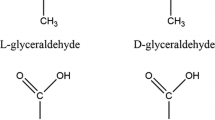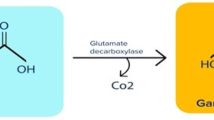Abstract
δ-Aminolaevulinic acid (ALA) has been shown to be toxic to cultured neurons and glia at concentrations as low as 10 μM. In an attempt to elucidate the mechanism of toxicity, the effects of ALA on membrane ATPase activity were investigated. Exposure of neuron cultures to 1 mM ALA for 7 days caused a substantial decrease in both Na+, K+-ATPase and Mg2+-ATPase activities. At lower concentrations, ALA affected only the Na+, K+-component. ALA appeared to act directly, inhibiting Na+, K+-ATPase activity in rat brain cortex membrane preparations at 10 μM Although this effect was slight, it may well represent the mechanism of action of ALA, since ouabain, a potent inhibitor of Na+, K+-ATPase activity, proved to be more toxic to cultured neurons than ALA. Furthermore, cardiac glycoside overdosage causes neurological disturbances which are very similar to those observed in the acute attack of porphyria.
Similar content being viewed by others
References
Sassa, S., andKappas, A. 1981. Genetic, metabolic and biochemical aspects of the porphyrias. Adv. Hum. Genet. 11:121–231.
Lee, W. R. 1981. What happens in lead poisoning? J. R. Coll. Physicians Lond. 15:48–54.
Cutler, M. G., Moore, M. R., andEwart, F. G. 1979. Effects of δ-aminolaevulinic acid administration on social behaviour in the laboratory mouse. Psychopharmacol. 61:131–135.
Sima, A. A. F., Kennedy, J. C., Blakeslee, D., andRobertson, D. M. 1981. Experiment porphyric neuropathy: A preliminary report. Can. J. Neurol. Sci. 8:105–114.
Russell, V. A., Lamm, M. C. L., andTaljaard, J. J. F. 1982. Effects of δ-aminolaevulinic acid porphobilinogen and structurally related amino acids on 2-deoxyglucose uptake in cultured neurons. Neurochem. Res. 7:1009–1022.
Nicoll, R. A. 1976. The interaction of porphyrin precursors with GABA receptors in the isolated frog spinal cord. Life Sci. 19:521–526.
Müller, W. E., andSnyder, S. H. 1977. δ-Aminolaevulinic acid: Influences on synaptic GABA receptor binding may explain CNS symptoms of porphyria. Ann. Neurol. 2:340–342.
Brennan, M. J. W., andCantrill, R. C. 1979. δ-Aminolaevulinic acid is a potent agonist for GABA autoreceptors. Nature 280:514–515.
Sokoloff, L., 1981 Circulation and energy metabolism of the brain. Pages 471–495,in Siegel, G. J., Albers, R. W., Agranoff, B. W., andKatzman, R., (eds.), Basic Neurochemistry, Little, Brown and Company, Boston.
Becker, D., Viljoen, D., andKramer, S. 1971. The inhibition of red cell and brain ATPase by δ-aminolaevulinic acid. Biochim. Biophys. Acta 225:26–34.
Percy, V. A., Lamm, M. C. L. andTaljaard, J. J. F. 1981. δ-Aminolaevulinic acid uptake, toxicity and effect on [14C] γ-aminobutyric acid uptake into neurons and glia in culture. J. Neurochem. 36:69–76.
Rodnight, R., andLavin, B. E. 1966. Enzyme transfer of phosphate from adenosine triphosphate to protein-bound serine residues in cerebral microsomes. Biochem. J. 101:495–501.
Shibata, Y., Ohzeki, H., Sato, M., Suzuki, Y., andTakiguchi, H. 1982. Inhibitory effect of prostaglandin A2 on Na+, K+-ATPase activity in synaptic plasma membrane of rat brain in vitro. Int. J. Biochem. 14:347–350.
Hems, D. A., andRodnight, R. 1966. Properties of phosphate bound to cerebral microsomes during adenosine-triphosphatase activity. Biochem. J. 101:516–523.
Rodnight, R., Hems, D. A., andLavin, B. E. 1966. Phosphate binding by cerebral microsomes in relation to adenosine-triphosphatase activity. Biochem. J. 101:502–515.
Ledig, M., Ciesielski-Treska, Cam, Y., Montagnon, D., andMandel, P. 1975. ATPase activity of neuroblastoma cells in culture. J. Neurochem. 25:635–640.
Elkouby, A., Ledig, M., andMandel, P. 1982. Effect of hydrocortisone and thyroxine on ATPase activities of neuronal and glial cell lines in culture. Neurochem. Res. 7:387–397.
Dichter, H. N., Taddeini, L., Lin, S., andAyala, G. F. 1977. Delta-aminolaevulinic acid. Effect of a porphyrin precursor on an isolated neuronal preparation. Brain Res. 126:189–195.
Lieberman, E. M., andNosek, T. M. 1976. The influence of chloride on the ouabainsensitive membrane potential and conductance of crayfish giant axons. Pflügers Archiv. Eur. J. Physiol. 366:195–202.
Cutler, M. G., Moore, M. R., andDick, J. M. 1980. Effects of δ-aminolaevulinic acid on contractile activity of rabbit duodenum. Eur. J. Pharmacol. 64:221–230.
Reyneke, L., McCarthy, B. W., Neethling, A. C., Russell, V. A., andTaljaard, J. J. F. 1983. Inhibition of the evoked release of dopamine from rat striatal synaptosomes by δ-aminolaevulinic acid. S. Afr. J. Sci. 79:249–250.
Fischer, H. G., Rudolph, E., andSchmidt, J. 1982. Relation between Na+, K+-ATPase activity and dopamine release from rat striatum slices. Acta Biol. Med. Ger. 41:471–476.
McIlwain, H., andBachelard, H. S. (eds.) 1971. Biochemistry and the Central Nervous System. Pages 32–60. Churchill Livingstone, Edinburgh and London.
Moe, G. K., andFarah, A. E. 1975. Digitalis and allied cardiac glycosides. Pages 653–682,in Goodman, L. S., andGilman, A. (eds.), The pharmacological basis of therapeutics, Macmillan Publishing Co., New York.
Author information
Authors and Affiliations
Rights and permissions
About this article
Cite this article
Russell, V.A., Lamm, M.C.L. & Taljaard, J.J.F. Inhibition of Na+, K+-ATPase activity by δ-aminolevulinic acid. Neurochem Res 8, 1407–1415 (1983). https://doi.org/10.1007/BF00964997
Accepted:
Issue Date:
DOI: https://doi.org/10.1007/BF00964997




